Adolescence (13–18)
Sensitive content warning
Caution: This content contains information some readers may find distressing.
If you, or someone you know, needs help contact Lifeline on 13 11 14.
For a list of support services visit crisis and support services.
Adolescents aged 13–18 make up the oldest child developmental stage. This age group tends to be in high school or undertaking an apprenticeship, and while they are beginning to physically resemble adults, there are still significant differences in maturity and decision-making capabilities (Arain et al. 2013). Additionally, adolescents may be more likely to engage in risky behaviours, such as experimenting with drugs or alcohol, or driving recklessly, which can increase their risk of injury (CARRS 2021).
Peer pressure and the desire to fit in can also play a role in teenagers' decision-making and may lead them to take risks that they otherwise would not, in addition to increased prevalence of mental health disorders that may lead to intentional self-injury (AIHW 2021a; Tian et al. 2019).
Within this developmental stage, children are split into ages 13–15 and 16–18 for analysis due to differences in injury mechanisms. The exception to this is intentional self-harm, where due to data sensitivities, the age groups are aggregated and presented as one.
Adolescents aged 13–15
Causes
Adolescents aged 13–15 are more likely than adults to be hospitalised for injuries caused by drowning and submersion, transport, and contact with living things. For each of these causes, boys make up the majority of cases (Figure 31).
Figure 31: Injury hospitalisation rate ratios of adolescents aged 13–15 compared to adults, and sex demographic proportions, by selected external cause, Australia, 2021–22

Older children are more at risk in natural water, such as the ocean, rivers, or lakes (Royal Life Saving Australia 2023).
Adolescents aged 13–15 are 2.1 times more likely than adults to be hospitalised for an injury caused by drowning and submersion (2.2 and 1.0 per 100,000 respectively). Around half of injury cases caused by drowning and submersion occurred while in natural water, such as the ocean or a lake (48%).
Adolescents aged 13–15 were 1.4 times more likely than adults to be hospitalised for an injury caused by transport (360 and 249 per 100,000 respectively). Boys in this age group had the highest rate of hospitalisation overall for transport collisions (554 per 100,000), and were 1.6 times more likely than men to be hospitalised.
The most common modes of transport for the injured child in this age group were:
- pedal cycle (46%)
- motorcycle (28%)
- car (9%).
Adolescents aged 13–15 were 1.3 times more likely than adults to be hospitalised for an injury caused by contact with living things (145 and 111 per 100,000 respectively). For boys in this age group, this increases to 1.6 times (201 and 122 per 100,000 respectively).
Nearly 2 in 5 hospitalisations caused by contact with living things involved being hit, struck, kicked, twisted, bitten or scratched by another person (39%), while a further 1 in 5 involved striking against or being bumped into by another person (22%).
Nature of injuries sustained
Adolescents aged 13–15 experience higher rates of injury than adults for certain injury types. This age group was 2.4 times more likely to have an ED presentation for poisoning or toxic effect, and 2.2 times more likely to be hospitalised (Figure 32).
Figure 32: Selected rate ratios of injury emergency presentations and hospitalisations among adolescents aged 13–15, by type of injury, 2021–22
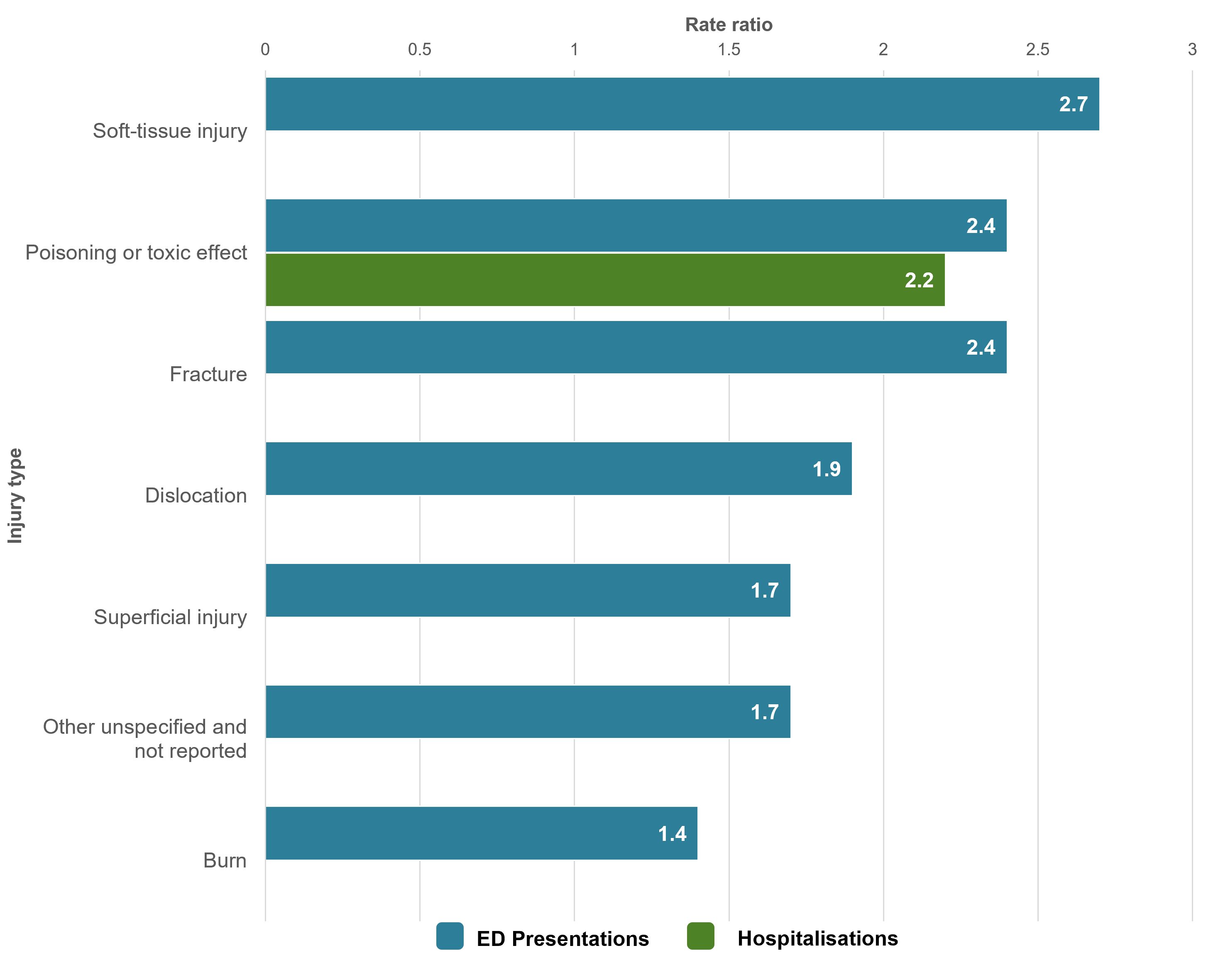
Some types of injury are more prevalent in children compared to adults only in one sex. When comparing girls aged 13–15 with women, girls were more likely to have an ED presentation for a:
- foreign object (through orifice) (2.0 times)
- crushing injury (1.5 times).
This age group was also 2.2 times more likely to be hospitalised for an injury involving poisoning or toxic effect. For girls, this increases to 3.5 times (515 and 147 per 100,000 respectively).
For hospitalisations there are also differences in injury mechanism by sex:
- girls are more likely than women to be hospitalised for a crushing injury (1.7 times) or foreign object (through orifice (1.3 times)
- boys are more likely than men to be hospitalised for a fracture (1.4 times).
The sites of injury that adolescents aged 13–15 are more likely than adults to have an ED presentation or hospitalisation are shown in Figure 33.
Figure 33: Selected rate ratios for emergency department presentations and hospitalisations among adolescents aged 13–15, by site of injury, Australia, 2021–22
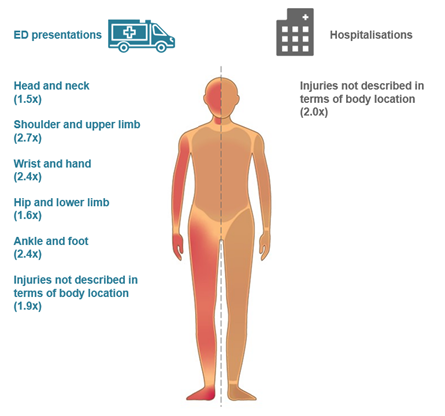
This age group was also more likely to be hospitalised for injuries not described in terms of body location (2.0 times). Boys were more likely than men to be hospitalised for injuries to the shoulder and upper limb (1.7 times).
Adolescents aged 16–18
Causes
Adolescents aged 16–18 are more likely than adults to be hospitalised for injuries caused by transport, undetermined intent, contact with living things, other unintentional causes, and assault. For each of these causes, boys make up the majority of cases (Figure 34).
Figure 34. Injury hospitalisation rate ratios of adolescents aged 16–18 compared to adults, and sex demographic proportions, by selected external cause, Australia, 2021–22
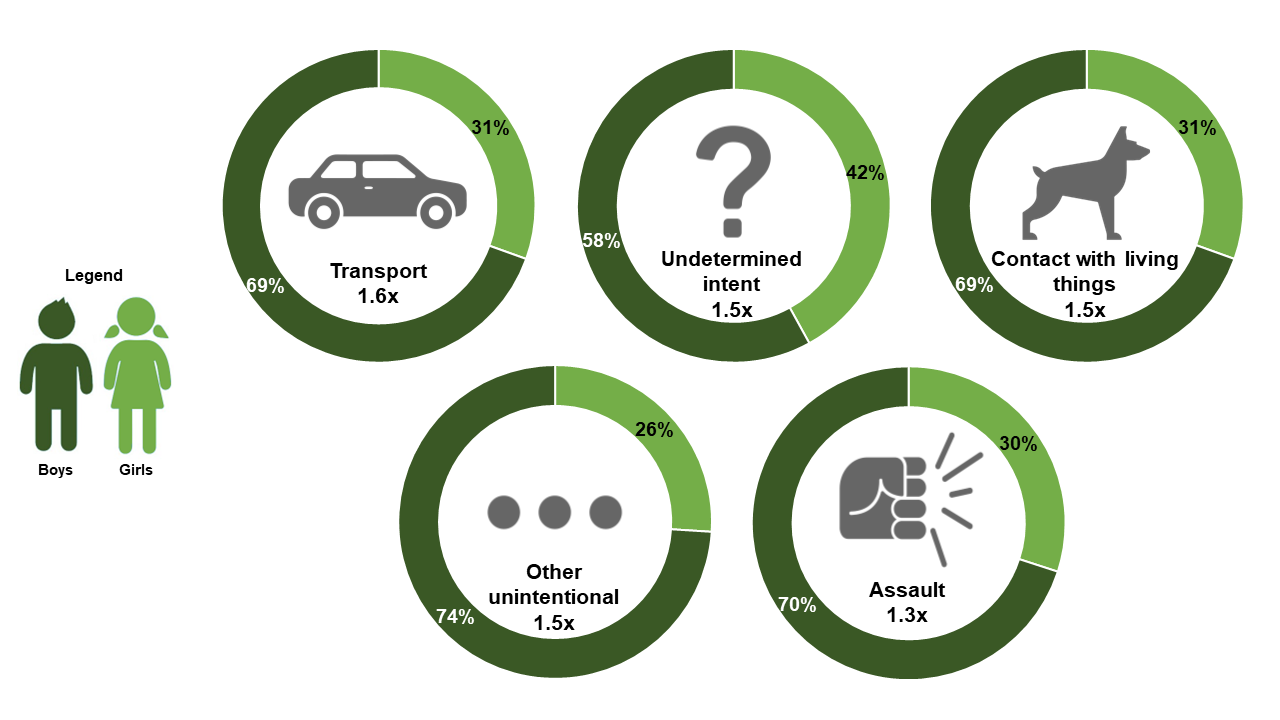
Some causes of injury are more prevalent in children compared to adults only in one sex. When comparing boys aged 16–18 with men, boys were 2.1 times more likely to be hospitalised for an injury caused by drowning and submersion.
Adolescents aged 16–18 were 1.6 times more likely than adults to be hospitalised for an injury caused by transport (404 and 249 per 100,000 respectively). 69% of these hospitalisations were for boys.
The most common modes of transport for the injured child in this age group were:
- car (35%)
- motorcycle (31%)
- pedal cycle (16%)
Adolescents aged 16–18 were 1.5 times more likely than adults to be hospitalised for an injury caused by contact with living things (164 and 111 per 100,000 respectively). For boys, this increases to 1.8 times (219 and 122 per 100,000).
2 in 5 hospitalisations caused by contact with living things involved being hit, struck, kicked, twisted, bitten or scratched by another person (40%), while a further 1 in 5 involved striking against or being bumped into by another person (21%).
Assault is intentional violence against another person resulting in injury. Adolescents and young adults aged 15–24 are the demographic in Australia most likely to experience physical assault (ABS 2023). This age group has a higher risk of experiencing workplace violence (Brown et al. 2020).
Adolescents aged 16–18 were 1.3 times more likely than adults to be hospitalised for an injury caused by assault (119 and 92 per 100,000 respectively). 70% of these hospitalisations were for boys.
3 in 5 assaults perpetrated against this age group were assault by bodily force (61%). 63% of these hospitalisations had a perpetrator specified; of these the most common were:
- multiple persons unknown to the victim (23%)
- person unknown to the victim (19%)
- spouse or domestic partner (17%).
Girls were more likely than boys to have an injury hospitalisation where the assault was perpetrated by a spouse or domestic partner (27 and 2.8 per 100,000 population respectively), while boys were more likely to report being assaulted by an unknown person (30 and 9.7 per 100,000 respectively).
In cases where the cause of injury is known but it is unclear if the act was accidental or intentional, hospital and death records can be coded to identify that the intent was undetermined. Adolescents aged 16–18 were 1.5 times more likely than adults to be hospitalised for an injury with undetermined intent (23 and 15 per 100,000 respectively). For girls, this increases to 1.7 times (20 and 11 per 100,000).
Poisoning was the most common external cause of injury (131, 64%), followed by contact with blunt object (33, 16%).
Other unintentional causes include unintentional injury hospitalisations not principally caused by any of the main causes described in the other cause groups, or where there may not have been enough information to specify the cause. Adolescents aged 16–18 were 1.5 times more likely than adults to be hospitalised for an injury caused by other unintentional causes (335 and 230 per 100,000 respectively).
Nature of injuries sustained
Adolescents aged 16–18 experience higher rates of injury than adults for certain injury types. This age group was 3.0 times more likely to have an ED presentation for poisoning or toxic effect, and 2.9 times more likely to be hospitalised (Figure 35).
Figure 35: Selected rate ratios of injury emergency department presentations and hospitalisations among adolescents aged 16–18, by type of injury, 2021–22

Boys aged 16–18 were 1.3 times more likely than men to have an ED presentation for internal organ injuries. They were also 1.3 times more likely to be hospitalised for intracranial injuries, dislocations, and nerve injuries.
Girls aged 16–18 were more likely than women to have an ED presentation for foreign object (through orifice) injuries (2.1 times), and other specified and/or multiple injuries (1.6 times). They were also 1.4 times more likely to be hospitalised for foreign object (through orifice) injuries.
Figure 36 shows the site of injury where adolescents aged 16–18 are more likely than adults to have an injury ED presentation or hospitalisation.
Figure 36: Selected rate ratios for emergency department presentations and hospitalisations among adolescents aged 16–18, by site of injury, Australia, 2021–22
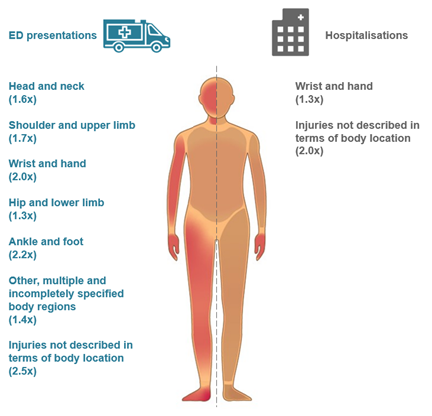
Boys are more likely than men to be hospitalised for injuries to the ankle and foot (1.4 times).
Intentional self-harm
Determining if an injury was intentional is not always straightforward, especially when children are involved. In very young children, confirming that an injury was due to intentional self‑harm can be difficult and may involve a parent or caregiver’s perception of the intent. Ability to form an intention to inflict self‑harm, and to understand the implications of doing so, requires a degree of maturity that is absent in infancy and early childhood. For this reason, statistics about hospitalisations due to intentional self-harm are presented here only for adolescents aged 13 to 18 as aggregated groups.
Note that values for intentional self-harm used in the Causes of injury chapter are for children and adolescents aged 0 to 18 inclusive, to allow for comparison between other cause groups. Consequently, there are variations in the rates presented between chapters.
For more information, see the AIHW’s reports on suicide and self-harm monitoring.
Research indicates that self-harm injuries are on the rise, and are contributing a greater proportion of injuries amongst adolescents and young adults aged 13–24 (Pollock et al. 2024). Adolescents are at a developmental stage where they are experiencing many physical, emotional, and social changes. These changes can be challenging and can contribute to feelings of stress, anxiety, and depression (Jiang et al. 2021). Adolescents may also struggle with issues related to identity, self-esteem, and relationships, which can increase their risk of engaging in self-harm or suicidal behaviours (McEvoy et al. 2023).
Additionally, adolescents may not have fully developed coping skills or support systems to help them deal with these challenges, which can make them more vulnerable to self-harm and suicide. Some population groups are at heightened risk of injury, including:
- adolescents in the youth justice and child welfare systems (Shepherd et al. 2018)
- First Nations adolescents (AIHW 2023e)
- the LGBTIQ+ community (Hill et al. 2023)
- adolescents living in rural and remote areas (Fitzpatrick et al. 2021).
Adolescents aged 13–18 were 3.4 times more likely than adults to be hospitalised for injuries caused by intentional self-harm. Over 4 in 5 of these hospitalisations were for girls (Figure 37).
Figure 37: Injury hospitalisation rate ratios of children aged 13–18 compared to adults, and sex demographic proportions, for hospitalisations caused by intentional self-harm, Australia, 2021–22
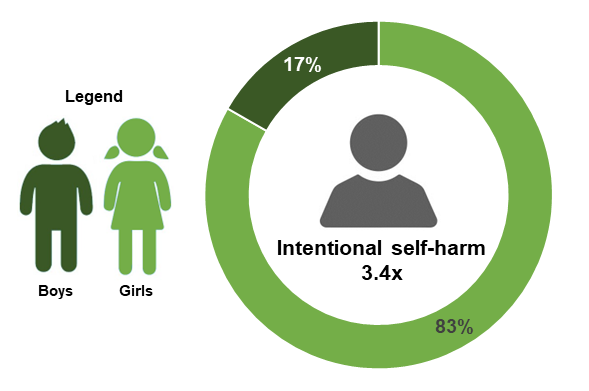
Girls are more likely to be hospitalised for intentional self-harm than boys
Girls aged 13–18 were hospitalised for injuries caused by intentional self-harm at a rate of 582 per 100,000 population. Comparatively, boys were hospitalised at a rate of 110 per 100,000.
87% of these hospitalisations for girls involved intentional self-poisoning, compared to 76% for boys. The most common external causes of injury for each sex were:
- girls – intentional self-poisoning by and exposure to nonopioid analgesics, antipyretics and antirheumatics (45%)
- boys – intentional self-poisoning by and exposure to antiepileptic, sedative-hypnotic, antiparkinsonism and psychotropic drugs, not elsewhere classified (34%).
It is important to note that while females generally have higher rates of hospitalisations caused by intentional self-harm, males have higher rates of death by suicide (AIHW 2023c).
ABS (Australian Bureau of Statistics) (2023) Crime Victimisation, Australia, ABS, Australian Government, accessed 22 February 2024.
AIHW (Australian Institute of Health and Welfare) (2021a) Australia's youth: Mental illness, AIHW, Australian Government, accessed 21 March 2024.
AIHW (2023e) Intentional self-harm hospitalisations among First Nations people, AIHW, Australian Government, accessed 16 February 2024.
Arain M, Haque M, Johal L, Mathur P, Nel W, Rais A, Sandhu R, Sharma S (2013) Maturation of the adolescent brain, Neuropsychiatric Disease and Treatment, 9:449-461, doi: 10.2147/NDT.S39776.
Brown B, Myers D, Casteel C & Rauscher K (2020) Exploring differences in the workplace violence experiences of young workers in middle and late adolescence in the United States, Journal of Safety Research, 74:263-9, doi: 10.1016/j.jsr.2020.06.008.
CARRS (Centre for Accident Research & Road Safety - Queensland) (2021) Adolescent risk-taking, CARRS, Queensland University of Technology, accessed 21 March 2024.
Fitzpatrick S, Handley T, Powell N, Read D, Inder K, Perkins D, Bronwyn B (2021) Suicide in rural Australia: A retrospective study of mental health problems, health-seeking and service utilisation, PLOS ONE, 16(7), doi: 10.1371/journal.pone.0245271.
Hill A, Lyons A, Jones J, McGowan I, Carman M, Parsons M et al. (2023) Writing Themselves In 4: The health and wellbeing of LGBTQA+ young people in Australia, La Trobe University, accessed 16 February 2024.
Jiang L, Yang D, Li Y & Yuan J (2021) The Influence of Pubertal Development on Adolescent Depression: The Mediating Effects of Negative Physical Self and Interpersonal Stress, Psychiatry, 12, doi: 10.3389/fpsyt.2021.786386.
McEvoy D, Brannigan R, Cooke L, Butler E, Walsh C, Arensman E, Clarke M (2023) Risk and protective factors for self-harm in adolescents and young adults: An umbrella review of systematic reviews, Journal of Psychiatric Research, 168:353-80, doi: 10.1016/j.jpsychires.2023.10.017.
Pollock Z, Draper G, Constantine W, Chalker E & Freebairn L (2024) Injury hospitalisations for children and young people: a (20-year review, Injury Prevention, doi: 10.1136/ip-2023-045099.
Royal Life Saving Australia (2023) National Drowning Report, Royal Life Saving Australia, accessed 21 February 2024.
Shepherd S, Spivak B, Borschmann R, Kinner S & Hachtel H (2018) Correlates of self-harm and suicide attempts in justice-involved young people, PLOS ONE, 13(2), doi: 10.1371/journal.pone.0193172.
Tian L, Dong X, Xia D, Liu L & Wang D (2019) Effect of peer pressure on adolescents' risk-taking is moderated by individual self-esteem: An experimental study, International Journal of Psychology 55(3), doi: 10.1002/ijop.12611.


